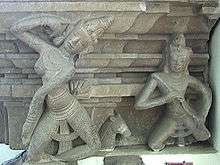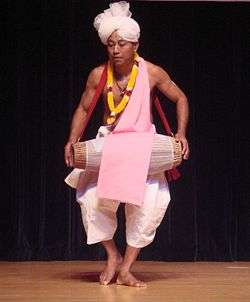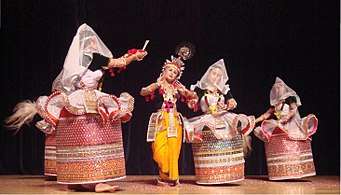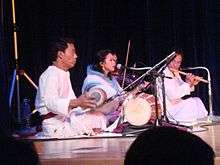Manipuri dance
Manipuri dance, also known as Jagoi,[1] is one of the major Indian classical dance forms,[2] named after the region of its origin – Manipur, a state in northeastern India bordering with Myanmar (Burma), Assam, Nagaland and Mizoram.[3][4] It is particularly known for its Hindu Vaishnavism themes, and exquisite performances of love-inspired dance drama of Radha-Krishna called Raslila.[3][1][5] However, the dance is also attributed to regional deities such as Umang Lai during Lai Haraoba.[6][7]

The roots of Manipuri dance, as with all classical Indian dances, is the ancient Hindu Sanskrit text Natya Shastra, with influences and the culture fusion between various local folk dance forms.[8] According to the traditional legend, the indigenous people of the Manipur valley were the dance-experts revered as Gandharvas in the Hindu epics (Ramayana and Mahabharata), suggesting a dance tradition has existed in Manipur since antiquity.[6][5][9] With evidence of Vishnu temples in the medieval era, the dance arts have been passed down verbally from generation to generation as an oral tradition.[10][11] The first reliably dated written texts describing the art of Manipuri dance are from the early 18th-century.[11]
The Manipuri dance is a team performance, with its own unique costumes, aesthetics, conventions and repertoire.[12] The Manipuri dance drama is, for most part, marked by a performance that is graceful, fluid, sinuous with greater emphasis on hand and upper body gestures.[13][14] It is accompanied with devotional music created with many instruments, with the beat set by cymbals (kartal or manjira) and double-headed drum (pung or Manipuri mrdanga) of sankirtan.[15]
Manipuri dance is a religious art and its aim is the expression of spiritual values. Aspects of this performance art is celebrated during Hindu festivals and major rites of passage such as weddings among the Manipuri people, particularly in the ethnic majority of Meitei people.[6] The dance drama choreography shares the plays and stories of 'Vaishnavite Padavalis', that also inspired the major Gaudiya Vaishnava-related performance arts found in Assam and West Bengal.[3][16]
History

According to tradition of the Manipuri people in the Himalayan foothills and valleys connecting India to Burma, they are the Gandharvas (celestial musicians and dancers) in the Vedic texts,[14] and historic texts of Manipuri people calls the region as Gandharva-desa.[17] The Vedic Usha, the goddess of the dawn, is a cultural motif for Manipuri women, and in the Indian tradition, it was Usha who created and taught the art of feminine dance to girls.[18] This oral tradition of women's dance is celebrated as Chingkheirol in the Manipuri tradition.[11]
The ancient Sanskrit texts such as the Mahabharata epic mentions Manipur, where Arjuna meets and falls in love with Chitragada.[14] Dance is called Jagoi in a major Meitei language of the region and it traces a long tradition in Manipur. Lai Haraoba dance likely has ancient roots and shares many similarities with dance postures of Nataraja and his legendary disciple called Tandu (locally called Tangkhu[11]).[14] Similarly, as does the dance related to commoner Khamba and princess Thoibi – who perform as pan-Indian Shiva and Parvati, in the legendary tragic love story of Khamba-Thoibi found in the Manipuri epic Moirang Parba.[14][19][20]
Medieval period
Historical texts of Manipur have not survived into the modern era, and reliable records trace to early 18th century.[21] Theories about the antiquity of Manipuri rely on the oral tradition, archaeological discoveries and references about Manipur in Asian manuscripts whose date can be better established.[21]
The text Bamon Khunthok, which literally means "Brahmin migration", states Panniker, states that Vaishnavism practices were adopted by the king of Manipur in the 15th century CE, arriving from Shan kingdom of Pong.[22] Further waves of Buddhists and Hindus arrived from Assam and Bengal, after mid 16th-century during Hindu-Muslim wars of Bengal Sultanate, and were welcomed in Manipur. In 1704, the King Charai Rongba adopted Vaishnavism, and declared it to be the state religion.[22] In 1717, the King Gareeb Niwaz converted to Chaitanya style devotional Vaishnavism, which emphasized singing, dancing and religious performance arts centered around Hindu god Krishna.[22] In 1734, devotional dance drama centered around Hindu god Rama expanded Manipuri dance tradition.[22]

Maharaja Bhagyachandra (r. 1759–1798 CE) of Manipur State adopted Gaudiya Vaishnavism (Krishna oriented),[23][24] documented and codified the Manipuri dance style, launching the golden era of its development and refinement.[25] He composed three of the five types of Ras Lilas, the Maha Ras, the Basanta Ras and the Kunja Ras, performed at the Sri Sri Govindaji temple in Imphal during his reign and also the Achouba Bhangi Pareng dance. He designed an elaborate costume known as Kumil (the cylindrical long mini-mirror-embellished stiff skirt costume, that makes the dancer appear to be floating).[23] The Govinda Sangeet Lila Vilasa, an important text detailing the fundamentals of the dance, is also attributed to him.[25][23] King Bhagyachandra is also credited with starting public performances of Raas Lila and Manipuri dances in Hindu temples.[23]
Maharaja Gambhir Singh (r. 1825–1834 CE) composed two parengs of the tandava type, the Goshtha Bhangi Pareng and the Goshtha Vrindaban Pareng. Maharaja Chandra Kirti Singh (r. 1849–1886 CE), a gifted drummer, composed at least 64 Pung choloms (drum dances) and two parengs of the Lasya type, the Vrindaban Bhangi Pareng and Khrumba Bhangi Pareng.[23] The composition of the Nitya Ras is also attributed to these kings.[26]
| Part of a series on the |
| Culture of India |
|---|
 |
| History |
| People |
|
Mythology and folklore |
| Cuisine |
| Religion |
|
|
Music and performing arts |
| Sport |
|
Monuments |
|
British rule era
In 1891, the British colonial government annexed Manipur into its Empire, marking an end to its golden era of creative systematization and expansion of Manipuri dance.[27] The Manipuri dance was thereafter ridiculed as immoral, ignorant and old-fashioned, like all other classical Hindu performance arts.[27] The dance and artists survived only in temples, such as in Imphal's Govindji temple. The cultural discrimination was resisted and the dance revived by Indian independence movement activists and scholars.[27]
Modern era
The Manipuri dance genre got a second life through the efforts of the Noble Laureate Rabindranath Tagore.[28][29] In 1919, he was impressed after seeing a dance composition of Goshtha Lila in Sylhet (in present-day Bangladesh). He invited Guru Budhimantra Singh who had trained in Manipuri dance, as faculty to the Indian culture and studies center named Shantiniketan.[27] In 1926, Guru Naba Kumar joined the faculty to teach the Ras Lila. Other celebrated Gurus, Senarik Singh Rajkumar, Nileshwar Mukherji and Atomba Singh were also invited to teach there and assisted Tagore with the choreography of several of his dance-dramas.[30]
Repertoire
The traditional Manipuri dance style embodies delicate, lyrical and graceful movements. The dance features rounded soft sensuous movements of women, and occasional fast movements by male characters.[13][14] Unlike other classical Indian dances with religious themes, the Manipuri dance artists do not wear anklet bells and the footwork is subdued and gentle in the Manipuri style. The stage movements is part of a composite movement of the whole body.[13][14]
Chali or Chari is the basic dance movement in Manipuri Ras dances.[31] The repertoire and underlying play depends on the season. The dances are celebrated on full moon nights, three times in autumn (August through November) and once again in spring (March or April). [31]The Vasant Ras is timed with the Hindu festival of colors called Holi, while others are timed with post-harvest festivals of Diwali and others. The plays and songs recited during the dance performance center around the love and frolics between Radha and Krishna, in the presence of Gopis named Lalita, Vishakha, Chitra, Champaklata, Tungavidya, Indurekha, Rangadevi and Sudevi.[32] There is a composition and dance sequence for each Gopi, and the words have two layers of meanings, one literal and other spiritual. The longest piece of the play focuses on Radha and Krishna.[31] The dancer playing Krishna expresses emotions, while the body language and hand gestures of the Gopi display their feelings such as longing, dejection or cheer.[33]
In other plays, the Manipuri dancers are more forceful, acrobatic and their costumes adjust to the need of the dance. Dozens of boys synchronously dance the Gopa Ras, where they enact the chores of daily life such as feeding the cows. In Uddhata Akanba, states Ragini Devi, the dance is full of vigor (jumps, squats, spins), energy and elegance.[31]
Costumes

The classical Manipuri dance features unique costumes. The women characters are dressed like a Manipuri bride, in Potloi costumes,[34] of which the most notable is the Kumil. A Kumil is an elaborately decorated barrel shaped long skirt stiffened at the bottom and close to the top. The decorations on the barrel include gold and silver embroidery, small pieces of mirrors, and border prints of lotus, Kwaklei orchid, and other items in nature.[34] The Kumil may be an adaptation of Fanek (or Phanek) – a tighter sarong-like wear which is used in more vigorous dances and by male characters.[35][36] The Kumil is bordered at the top with undulating gauzy translucent top skirt shaped like an open flower, and tied in Trikasta or three places around the waist (front, back and one side) with spiritual symbolism of the ancient Hindu texts.[34] The upper body is dressed in a velvet blouse, the head covered in a white translucent veil, to symbolically mark elusiveness. The dancers do not wear bells on ankles as in other classical Indian dances, but like them Manipuri dance artists do adorn the face, neck, waist, hands and legs with round jewelry ornaments or flower garlands that flow with the dress symmetry.[35] The symmetrical translucent dress, states Reginald Massey, makes "the dancers appear to float on the stage, as if from another world".[37]
The male characters dress in a dhoti (also called dhotra or dhora) – a brilliantly colored broadcloth pleated, wrapped and tied at waist and allowing complete freedom of movement for the legs. The Krishna character wears a peacock feather containing crown, with a feathery attachment at the back.[34]
The costume tradition of the Manipuri dance celebrates its more ancient artistic local traditions, fused with the spiritual ideas embedded in the love story of Radha-Krishna found in the tenth book of the Bhagavata Purana.[34][38]

Music and instruments
The musical accompaniment for Manipuri dance comes from a percussion instrument called the Pung (a barrel drum[39]), a singer, small kartals (cymbals), sembong, harmonium, a stringed instrument called the pena and wind instrument such as a flute.[40]
The drummers are male artistes and, after learning to play the pung, students train to dance with it while drumming. This dance is celebrated, states Massey, with the dancer wearing white turbans, white dhotis, a folded shawl over the left shoulder, and the drum strap worn over the right shoulder.[39] It is known as Pung cholom, and the dancer plays the drum and performs the dance jumps and other movements.[39]
Another dance called Kartal cholom, is similar to Pung cholom, but the dancers carry and dance to the rhythm created with cymbals.[41] This is a group dance, where dancers form a circle, move in the same direction while making music and dancing to the rhythm.[42] Women dance too as groups, such as in the Manipuri dance called Mandilla cholom, and these usually go with devotional songs and playing colorful tassels-string tied cymbals where one side represents Krishna and the other Radha.[42] Shaiva (tandava) dances are choreographed as Duff cholom and Dhol cholom.[42]
The lyrics used in Manipuri are usually from the classical poetry of Jayadeva, Vidyapati, Chandidas, Govindadas or Gyandas and may be in Sanskrit, Maithili, Brij Bhasha or others.
Styles
The traditional Manipuri Ras Lila is performed in three styles – Tal Rasak, Danda Rasak and Mandal Rasak.[43] A Tal Rasak is accompanied with clapping, while Danda Rasak is performed by synchronous beat of two sticks but the dancers position it differently to create geometric patterns.[43] The Mandal Rasak places the Gopis in a circle, the Krishna character in the center, and then they dance in this mandala.[43]
The Manipuri dance is also categorized as either tandav (vigorous, usually go with Shiva, Shakti or Krishna as warrior-savior themed plays) or lasya (delicate,[44] usually go with love stories of Radha and Krishna).[45][46]
See also
- Rajkumar Singhajit Singh
- Darshana Jhaveri
- Manipuri Sankirtana
- Shija Lailoibi
References
- Reginald Massey 2004, p. 177.
- Williams 2004, pp. 83-84, the other major classical Indian dances are: Bharatanatyam, Kathak, Odissi, Kathakali, Kuchipudi, Cchau, Satriya, Yaksagana and Bhagavata Mela.
- James G. Lochtefeld (2002). The Illustrated Encyclopedia of Hinduism: A-M. The Rosen Publishing Group. pp. 420–421. ISBN 978-0-8239-3179-8.
- Reginald Massey 2004, pp. 177-187.
- Ragini Devi 1990, pp. 175-180.
- Reginald Massey 2004, pp. 177-180.
- Saroj Nalini Parratt (1997). The pleasing of the gods: Meitei Lai Haraoba. Vikas Publishers. pp. 14–20, 42–46.
- Saryu Doshi 1989, pp. xv-xviii.
- Saryu Doshi 1989, p. xii.
- Saryu Doshi 1989, pp. ix-xii, 5-6.
- Reginald Massey 2004, p. 179.
- Saryu Doshi 1989, pp. 19-20, 93-99.
- Farley P. Richmond, Darius L. Swann & Phillip B. Zarrilli 1993, pp. 174-175.
- Ragini Devi 1990, p. 176.
- Saryu Doshi 1989, pp. 78-84.
- Saryu Doshi 1989, pp. vii, 6-7, 25-26.
- Reginald Massey 2004, p. 178.
- Reginald Massey 2004, p. 17tfggy.
- Reginald Massey 2004, pp. 178-181.
- Shovana Narayan (2011). The Sterling Book of Indian Classical Dance. Sterling Publishers. p. 54. ISBN 978-81-207-9078-0.
- Reginald Massey 2004, pp. 178-180.
- K Ayyappap Panikkar (1997). Medieval Indian Literature: Surveys and selections. Sahitya Akademi. pp. 325–329. ISBN 978-81-260-0365-5.
- Shovana Narayan (2011). The Sterling Book of Indian Classical Dance. Sterling Publishers. pp. 55–58. ISBN 978-81-207-9078-0.
- Reginald Massey 2004, pp. 181-184.
- Reginald Massey 2004, pp. 184-186.
- Singha, R. and Massey R. (1967) Indian Dances, Their History and Growth, Faber and Faber, London, pp.175–77
- Reginald Massey 2004, pp. 185-186.
- Reginald Massey 2004, pp. 186-187.
- Naorem Sanajaoba (1988). Manipur, Past and Present: The Heritage and Ordeals of a Civilization. Mittal Publications. p. 131. ISBN 978-81-7099-853-2.
- Singha, R. and Massey R. (1967) Indian Dances, Their History and Growth, Faber and Faber, London
- Ragini Devi 1990, pp. 177-179.
- Ragini Devi 1990, p. 179.
- Shovana Narayan (2011). The Sterling Book of Indian Classical Dance. Sterling Publishers. pp. 58–59. ISBN 978-81-207-9078-0.
- Jamini Devi (2010). Cultural History of Manipur: Sija Laioibi and the Maharas. Mittal Publications. pp. 61–69. ISBN 978-81-8324-342-1.
- Shovana Narayan (2011). The Sterling Book of Indian Classical Dance. Sterling Publishers. pp. 57–58. ISBN 978-81-207-9078-0.
- Reginald Massey 2004, pp. 184-185.
- Reginald Massey 2004, p. 184.
- Peter J. Claus; Sarah Diamond; Margaret Ann Mills (2003). South Asian Folklore: An Encyclopedia. Routledge. p. 514. ISBN 978-0-415-93919-5.
- Reginald Massey 2004, p. 198.
- S Prajnanananda (1981). A historical study of Indian music. Munshiram Manoharlal. p. 223.
- Reginald Massey 2004, pp. 198-199.
- Reginald Massey 2004, p. 199.
- Reginald Massey 2004, p. 193.
- Vimalakānta Rôya Caudhurī (2000). The Dictionary of Hindustani Classical Music. Motilal Banarsidass. p. 80. ISBN 978-81-208-1708-1.
- Reginald Massey 2004, pp. 193-194.
- Saryu Doshi 1989, pp. xvi-xviii, 44-45.
Bibliography
- Saryu Doshi (1989). Dances of Manipur: The Classical Tradition. Marg Publications. ISBN 978-81-85026-09-1.CS1 maint: ref=harv (link)
- Manipuri by R K Singhajit Singh, Dances of India series, Wisdom Tree, ISBN 81-86685-15-4.
- Devi, Pukhrambam Lilabati. Pedagogic Perspectives in Indian Classical Dance: The Manipuri and The Bharatanatyam. ISBN 978-9382395393.
- Ragini Devi (1990). Dance Dialects of India. Motilal Banarsidass. ISBN 978-81-208-0674-0.CS1 maint: ref=harv (link)
- Natalia Lidova (2014). "Natyashastra". Oxford University Press. doi:10.1093/obo/9780195399318-0071. Cite journal requires
|journal=(help) - Natalia Lidova (1994). Drama and Ritual of Early Hinduism. Motilal Banarsidass. ISBN 978-81-208-1234-5.
- Williams, Drid (2004). "In the Shadow of Hollywood Orientalism: Authentic East Indian Dancing" (PDF). Visual Anthropology. Routledge. 17 (1): 69–98. doi:10.1080/08949460490274013.CS1 maint: ref=harv (link)
- Tarla Mehta (1995). Sanskrit Play Production in Ancient India. Motilal Banarsidass. ISBN 978-81-208-1057-0.
- Reginald Massey (2004). India's Dances: Their History, Technique, and Repertoire. Abhinav Publications. ISBN 978-81-7017-434-9.CS1 maint: ref=harv (link)
- Emmie Te Nijenhuis (1974). Indian Music: History and Structure. BRILL Academic. ISBN 90-04-03978-3.
- Kapila Vatsyayan (2001). Bharata, the Nāṭyaśāstra. Sahitya Akademi. ISBN 978-81-260-1220-6.
- Kapila Vatsyayan (1977). Classical Indian dance in literature and the arts. Sangeet Natak Akademi. OCLC 233639306., Table of Contents
- Kapila Vatsyayan (1974). Indian classical dance. Sangeet Natak Akademi. OCLC 2238067.
- Kapila Vatsyayan (2008). Aesthetic theories and forms in Indian tradition. Munshiram Manoharlal. ISBN 978-8187586357. OCLC 286469807.
- Kapila Vatsyayan. Dance In Indian Painting. Abhinav Publications. ISBN 978-81-7017-153-9.
- Wallace Dace (1963). "The Concept of "Rasa" in Sanskrit Dramatic Theory". Educational Theatre Journal. 15 (3): 249. doi:10.2307/3204783. JSTOR 3204783.
- Farley P. Richmond; Darius L. Swann; Phillip B. Zarrilli (1993). Indian Theatre: Traditions of Performance. Motilal Banarsidass. ISBN 978-81-208-0981-9.CS1 maint: ref=harv (link)
External links
| Wikimedia Commons has media related to Manipuri dance. |
- All about Manipuri dance, History and development of Manipuri dance forms, Dance costumes, Dance style, Famous Manipuri artists
- Manipuri dance, Raas Lila, Video clip (1 minute 29 seconds)
- Official list of Sangeet Natak Akademi Award recipients in Manipuri


